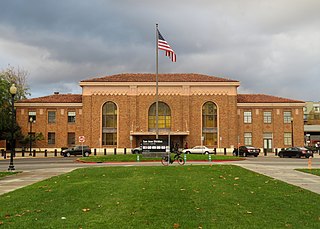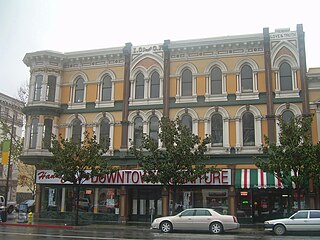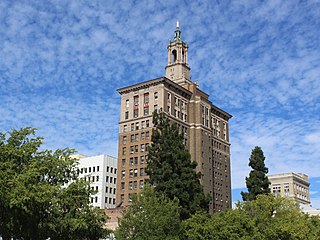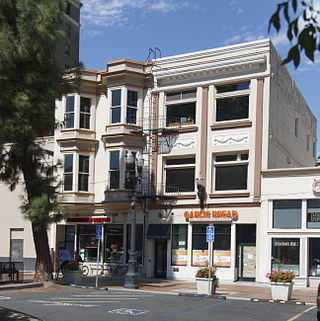
Victorian architecture is a series of architectural revival styles in the mid-to-late 19th century. Victorian refers to the reign of Queen Victoria (1837–1901), called the Victorian era, during which period the styles known as Victorian were used in construction. However, many elements of what is typically termed "Victorian" architecture did not become popular until later in Victoria's reign, roughly from 1850 and later. The styles often included interpretations and eclectic revivals of historic styles (see Historicism). The name represents the British and French custom of naming architectural styles for a reigning monarch. Within this naming and classification scheme, it followed Georgian architecture and later Regency architecture and was succeeded by Edwardian architecture.

Bernard Ralph Maybeck was an American architect in the Arts and Crafts Movement of the early 20th century. He worked primarily in the San Francisco Bay Area, designing public buildings, including the Palace of Fine Arts in San Francisco, and also private houses, especially in Berkeley, where he lived and taught at the University of California. A number of his works are listed on the National Register of Historic Places.

The Fan is a district of Richmond, Virginia, so named because of the "fan" shape of the array of streets that extend west from Belvidere Street, on the eastern edge of Monroe Park, westward to Arthur Ashe Boulevard. However, the streets rapidly resemble a grid after they go through what is now Virginia Commonwealth University. The Fan is one of the easterly points of the city's West End section, and is bordered to the north by Broad Street and to the south by VA 195, although the Fan District Association considers the southern border to be the properties abutting the south side of Main Street. The western side is sometimes called the Upper Fan and the eastern side the Lower Fan, though confusingly the Uptown district is located near VCU in the Lower Fan. Many cafes and locally owned restaurants are located here, as well as historic Monument Avenue, a boulevard formerly featuring statuary of the Civil War's Confederate president and generals. The only current statue is a more modern one of tennis icon Arthur Ashe. Development of the Fan district was strongly influenced by the City Beautiful movement of the late 19th century.

The Alameda is a historic district of Central San Jose, California, west of Downtown San Jose. The district is centered on an alameda, a historic portion of El Camino Real connecting Downtown San Jose to Mission Santa Clara de Asís, and includes the smaller, surrounding neighborhoods to the north and east, like College Park and St. Leo's.

San Jose Diridon station is the central passenger rail depot for San Jose, California. It also serves as a major intermodal transit center for Santa Clara County and Silicon Valley. The station is named after former Santa Clara County Supervisor Rod Diridon Sr.

Churrigueresque, also but less commonly "Ultra Baroque", refers to a Spanish Baroque style of elaborate sculptural architectural ornament which emerged as a manner of stucco decoration in Spain in the late 17th century and was used until about 1750, marked by extreme, expressive and florid decorative detailing, normally found above the entrance on the main façade of a building.

The Downtown Historic District of San Jose, California is a designated U.S. Historic District area of the city roughly the size of one square block. It is bounded by S. First Street to the west, E. San Fernando Street to the south, S. Third Street to the east, and E. Santa Clara Street to the north, but also includes the south side of E. Santa Clara Street between Third and Fourth Streets.

Palo Alto station is an intermodal transit center in Palo Alto, California. It is served by Caltrain regional rail service, SamTrans and Santa Clara VTA local bus service, Dumbarton Express regional bus service, the Stanford University Marguerite Shuttle, and several local shuttle services. Palo Alto is the second-busiest Caltrain station after San Francisco, averaging 7,764 weekday boardings by a 2018 count. The Caltrain station has two side platforms serving the two tracks of the Peninsula Subdivision and a nearby bus transfer plaza.

Albert Pissis (1852–1914) was a prolific Mexican-born American architect, of French and Mexican descent. He was active in San Francisco and had studied at the École des Beaux-Arts in Paris, France. He is credited with introducing the Beaux-Arts architectural style to San Francisco, California, designing a number of important buildings in the city in the years before and after the 1906 San Francisco earthquake.

Hepner Hall is an academic building at San Diego State University. The original entrance to the university, it is the oldest building on the campus. It was designed by the senior architectural designer of the California Division of the State Architect, Howard Spencer Hazen, and completed in 1931. Hepner Hall is regarded and commonly used as a symbol of the university and its campus.

The Bank of Italy Building is a 14-story, 77.72 m (255.0 ft) Renaissance Revival high-rise built in 1925 in downtown San Jose, California. This building became the second home to the first branch of the Bank of Italy, founded in San Francisco in 1904, which later became the Bank of America. The first location of the Bank of Italy in San Jose, was on the corner of Santa Clara St. and Lightson Alley, near the intersection with Market Street. Restaurants and other businesses occupy the original building, which has been heavily remodeled. A reconstruction of the original building is at History Park in San Jose.
In the United States, the National Register of Historic Places classifies its listings by various types of architecture. Listed properties often are given one or more of 40 standard architectural style classifications that appear in the National Register Information System (NRIS) database. Other properties are given a custom architectural description with "vernacular" or other qualifiers, and others have no style classification. Many National Register-listed properties do not fit into the several categories listed here, or they fit into more specialized subcategories.

The C. A. Belden House is a historic building in the Pacific Heights neighborhood of San Francisco, California, United States. It was designed by Walter J. Mathews in the Queen Anne style and completed in 1889.

In the New World, Queen Anne Revival was a historicist architectural style of the late 19th and early 20th centuries. It was popular in the United States, Canada, Australia, and other countries. In Australia, it is also called Federation architecture.

Cathedral Historic District, originally the Sioux Falls Historic District, is located in Sioux Falls, South Dakota. Named for its centerpiece and key contributing property, the Cathedral of Saint Joseph, the district covers the neighbourhood historically known as Nob Hill, where multiple prominent pioneers, politicians, and businessmen settled in the late 19th and early 20th centuries. These homes primarily reflect Queen Anne and Mediterranean Revival architectural styles. In 1974, the neighborhood was listed as a historic district on the National Register of Historic Places (NRHP); at the time of this listing, there were 223 buildings, not all contributing, within the district's boundaries. The district was enlarged in 2023.

The Hensley Historic District, also known as Northside Residential District, is a U.S. historic district and residential neighborhood in San Jose, California. The neighborhood is northeast of downtown and is roughly bounded by East Julian Street, North 1st Street, North 7th Street, and East Empire Street. It is listed as a California Historical Landmark since June 21, 1983; and is listed as one of the National Register of Historic Places (NRHP) since June 21, 1983.

The Moir Building, was formerly the Straford Hotel, and then in the 1930s named the St. James Hotel. It is a historic building located in downtown San Jose, California, next to the St. James Park. It was built in 1893–1894 and designed by W.D. Van Siclen. The building was placed on the National Register of Historic Places on October 29, 1982. It is one of the last remaining examples of late 19th-century Queen Anne and Romanesque Revival architecture in San Jose.

The Earl and Virginia Young House, also known as the Young-Sartorette House, stands as a historic residence in Campbell, California. Constructed in 1928, it served as the home for Earl Young, a successful orchard farmer in the Santa Clara Valley, and his family. The house is historically significant in the Tudor Revival architectural style, which gained popularity in the mid-twentieth century. In 1981, the Herz family relocated both the house and garage to prevent them from potential demolition. The Young-Sartorette House was placed on the National Register of Historic Places on January 8, 2009.

27–29 Fountain Alley is a historic commercial building located in San Jose, California. The building is architecturally significant as the only representative of late Victorian-style in this area. Its historically important for its association with Fountain Alley, one of San Jose oldest streets. The Fountain Alley building at 27–29 Fountain Alley was placed on the National Register of Historic Places on March 2, 1982.

The Ernest & Emily Renzel House is a historic residence in San Jose, California. The house was the residence of San Jose mayor Ernie Renzel, and for being one of the first Ranch style homes built in the Naglee Park conservation area. It was placed on the National Register of Historic Places on September 23, 2010.






















